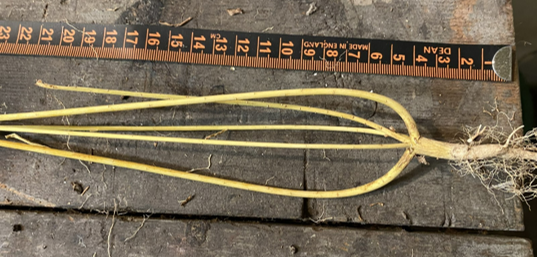

Grow flax cultivar ‘Marilyn’ for fibre and ‘Linore x Agatha’ for seed; yields increase with seeding rate
Sustainable Agriculture Student Research Project
Effects of flax variety and planting density on seed and fibre yieldKayla Buttress, Department of Sustainable Agriculture, 2024 |
Introduction
- Flax (Linum usitatissimum) is a versatile crop, known for its value in seed and fibre production
- With rising concerns about local food security and general sustainability of the textile industry, interest in sustainable alternatives is increasing.
- Different planting densities are recommended for seed and fibre production, but research is lacking for Fraser Valley growing conditions
- Optimizing cultivation practices is essential for enhancing crop yields, improving sustainability, and ensuring economic viability for local farmers
Objective
- Compare seed and fibre yield across four varieties of flax planted at four different densities
Methods
- Location: KPU Farm on Garden City Lands, Richmond, British Columbia
- Completely randomized design with one replicate
- Four varieties:
- Avian
- Dutch variety known to have high quality fibre and high fibre yields.
- Linore x Agatha, hybrid
- Linore, a winter hardy, dual-purpose variety developed by Oregon State University.
- Agatha, a traditional fibre variety from the Netherlands.
- Emeraude
- French variety recognized for high fibre content. Reported to be one of the finest fibre varieties grown recreationally in the Lower Mainland.
- Marilyn
- Dutch variety developed for fibre production.
- Known to require favourable weather conditions.
- Avian
- Planted at four different densities, resulting in 16 plots
- Plot size: 1 x 1 m
- Stems collected from 40 x 40 cm square in centre of each plot to reduce edge effects
- Completely randomized design, analyzed using a linear regression
- Sown on April 2, 2024, harvested mid-July
Image

Data collection:
- Seed yield, taken as the total weight of seeds produced
- Stem length, measured as the average of 20 randomly selected stems within each plot
- Fibre yield, measured as the total weight of flax fibre produced after processing
Processing flax into fibre
- Water retting to break down outer plant material, helping release fibres inside the shaft.
- Breaking the flax to crush the outer plant material into small pieces that can be removed during the next step.
- Scutching, using a metal bench scraper against a wood surface to scrape plant material off of fibres.
- Hackling to further remove plant material by combing through the flax fibres. Hackling also separates long fibres (line) from short fibres (tow). Only long fibres were used for data in this experiment.
Image

Results
Seed Yield
- Planting density was positively correlated with seed yield across all varieties (p = 0.027).
- Variety had a significant effect on seed yield (p < 0.05). Linore x Agatha produced the highest total seed yield (206 g/m2) while there were negligible differences between seed yield of other varieties (average of 113 g/m2).
Image

Image

Stem Length
- Stem length and planting density were positively associated (p = 0.029).
- Variety had a strong effect on stem length (p = 0.005). Emeraude produced the longest stems across all varieties with an average of 77.5 cm while Avian produced the shortest at 52.7 cm.
Image

Image

Fibre Yield
- Fibre yield increased with planting density (p = 0.003).
- Variety had a strong effect on fibre yield (p = 0.005). Across all densities, Marilyn produced an average of 177 g/m2 grams while Linore x Agatha produced an average of 46 g/m2.
Image

Image

Discussion
- Higher planting densities were expected to promote fibre production and lower planting densities to promote seed production. This was not always the case.
- Each variety had different strengths:
- Marilyn was the top fibre producer
- Linore x Agatha was the top seed producer
- Emeraude and Avian were strong multi-purpose varieties, but Avian’s shorter stem length would reduce potential fibre lengths
- When planted at 2500 seeds/m², Linore x Agatha had severely limited seed and fibre yields, as well as reduced stem length. This plot was identified as an outlier and data was excluded from all analyses.
- Flax seed is known to have a half-life of two to four years and the exact age of seed used in this experiment is unknown.
- Linore x Agatha had the lowest germination rate (leading to a lower actual density) while still producing the highest amount of seed. At lower planting densities of Linore x Agatha, a higher amount of stem branching was observed (Figure 8):
- 1000 seeds/m² - 43%
- 1500 seeds/m² - 40%.
- 2000 seeds/m² - 21.5%
- 2500 seeds/m² had no stem branching
- Branching was not observed in other varieties.
Image

- There is a presumption of decreased accuracy for planting density due to hand-sowing seeds. Future research might employ the use of a mechanical seeder to increase accuracy.
- Flax has an extensive root system, much of which remains in the ground after harvest. This feature and the ability to thrive in low-nutrient, disturbed environments makes flax a great choice for stabilizing soils and restoring degraded land.
Image

Conclusion
- Planting density does not always correlate with seed or fibre yield; variety is a greater predictor of production.
- Grow flax cultivar ‘Marilyn’ for fibre and ‘Linore x Agatha’ for seed.